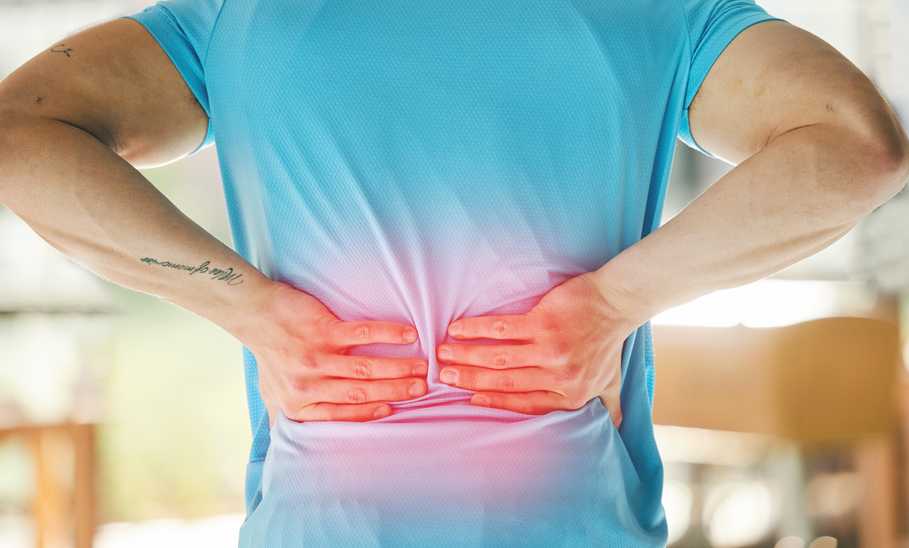What Causes Back Pain?

Our evaluations and opinions are not influenced by our advertising relationships, but we may earn a commission from our partners’ links. This content is created by TIME Stamped, under TIME’s direction and produced in accordance with TIME’s editorial guidelines and overseen by TIME’s editorial staff. Learn more about it.
Back pain can occur for many reasons, including injury, disease, genetic conditions, stress, and strain on the back muscles. Over 80% of Americans will suffer from back pain in their lifetime. But why? According to the National Center for Complementary and Integrative Health, pain in the “low-back is the most frequent cause of job-related disability and a leading contributor to missed work days and visits to physicians.”
As a fellow lower back pain sufferer myself, I reached out to the experts to get their opinions on why back pain happens and how we can ease it.
According to doctors and researchers at the National Institute of Arthritis and Musculoskeletal and Skin Diseases (NIAMS) there are three types of back pain:
This type of pain strikes fast and may hurt badly, but often, with the right combination of treatments, it lasts a few days up to a few weeks. Acute back pain usually occurs for a reason—you injure yourself and the pain is often related to muscular issues, like a strain.
This type of pain may happen suddenly or build up over time. Subacute usually lasts one to three months and can also be linked to an injury or issue with the spine.
Chronic back pain This type of pain happens daily, can last longer than 12 weeks, and often doesn’t respond as quickly to treatments as acute or subacute pain.
In addition, when considering back pain, you can categorize it according to where it corresponds to the back, says Brittany Ferri, PhD, OTR/L, an occupational therapist for the National Council on Aging (NCOA). “Back pain can be categorized as lower back pain, which is most common, upper-back pain, and middle-back pain. Risk factors include aging, physical inactivity, obesity, physically strenuous work, prolonged sitting, and smoking.”
Unfortunately, back pain may be common for people who are obese or not physically fit. This occurs often when you have a weak core and back muscles that don’t support and protect the spine. Of course, overdoing it or exercising without proper form can also cause back pain, so it’s important to work with a trainer if you’re starting an exercise program with back pain. “Excessive back flexion and extension exercises with heavy weights can lead to increased back pain,” warns Nick Jain, MD, a board-certified orthopedic spine surgeon at DISC Sports & Spine Center in southern California.
“[Overall] keeping weight down, core strengthening, maintaining a healthy, active lifestyle, and avoiding high-impact activities are all great ways to ease back pain,” says Dr. Jain.
Back pain can also be caused by simple factors like “aging, poor posture, weak core muscles,” says Dr. Jain. In addition, you risk back pain if you lead a sedentary lifestyle, smoke, and, unsurprisingly, stress and inflammation can all contribute to back pain.
A hard fall, car accident, or injury can result in back pain, sometimes chronic pain. For certain jobs that entail physical labor, back pain can be a risk. The NIAMS website reports that “jobs that require heavy lifting, pushing, pulling, or twisting can injure the back. A desk job may also play a role, especially if you have poor posture or sit all day in an uncomfortable chair.”
Common causes of back pain that are medical issues include degenerative arthritis or degenerative disc disease, says Dr. Jain.
Back pain may occur in the upper, middle, or lower back. It can feel sharp and stabbing, a dull, steady ache, or an intense spasm. It can come and go, flare up suddenly and last for weeks, or be continuous, chronic pain.
Other symptoms may include:
There are seemingly endless causes of back pain. In fact, they’re too numerous to list. Here are a few common causes of different types of back pain, according to orthopedic specialists, physical therapists, and NIAMS data.
If you're suffering from back pain, see a specialist to rule out anything serious. “If you experience back pain, you should see an orthopedist if any red flags are present, such as sudden changes in bowel/bladder control, unexplained weight gain/loss, numbness/tingling in the groin area, or saddle paresthesia,” says physical therapist Elizabeth Gimmison, PT, DPT, at FYZICAL Therapy & Balance Centers in Centerville, Ohio.
“Other reasons to see an orthopedist for back pain include back pain caused by trauma, like a fall, or your body not responding to conservative management such as rest, over-the-counter pain medication, heat/ice, or assistance through physical therapy, chiropractic, and/or massage,” she says.
Dr. Jain says standing lumbar X-rays and MRIs can often provide physicians and surgeons with information about the causes of back pain and help them make a diagnosis that will lead to the right treatment. Once the cause of back pain is identified, customized treatment can begin.
Managing chronic back pain typically involves a combination of methods, including pain relief medications, physical therapy, application of heat or cold, exercise, weight loss, and possibly acupuncture, massage, or cognitive behavioral therapy,” says Dr. Ferri. “For severe cases, surgery might be considered. Treatment should be tailored to each person’s symptoms and medical history."
Depending on the severity of the pain and other factors, a physician may recommend over-the-counter nonsteroidal anti-inflammatory drugs (NSAIDs) or prescription pain medication and/or muscle relaxers. In addition, CBD pain relief salves (my choice), Tiger Balm, and other similar lotions or creams designed specifically to target sore and painful muscles can be used. In some cases, cortisone shots may be administered by an orthopedist.
To manage back pain, a physical therapist may recommend strengthening core and back muscles, spinal alignment, and other exercises. Some people report relief from seeing a chiropractor, massage therapist, or acupuncturist. Cold and hot compresses may also help in the acute phase of a spasm.
While anyone can be afflicted with back pain, experts recommend losing weight, exercising, stretching, and walking may help alleviate or help manage and treat back pain. Quitting smoking and stress reduction may help as well. To support you while you’re sleeping, consider a mattress for back pain. If you have a desk job, consider getting an office chair for back pain.
As mentioned earlier, it may be impossible to avoid back pain, but keeping weight down, walking, swimming, taking pilates, yoga, and stretching your body daily—i.e., enjoying an active lifestyle to the best of your ability—are ways to keep your back and core muscles strong. Getting enough rest, quitting smoking, and managing stress may also help. If applicable, a person can also try switching to bras for large breasts which can provide extra support.
When your pain flares up, pay attention to it by visiting your orthopedist or physical therapist. Make sure to rest, apply ice and heat, and take anti-inflammatories — anything to give the spasms a chance to relax. The experts I spoke to agreed that you shouldn’t work or try to exercise through back pain.
You should always see a medical professional if you’re concerned about back pain, especially after an injury like a fall or car accident. If you have severe, debilitating pain, new neurologic deficits or significant weakness in the arms or legs, bowel or bladder incontinence, fevers, or worsening numbness or tingling, says Dr. Jain, you should see a doctor immediately.
The information presented here is created by TIME Stamped and overseen by TIME editorial staff. To learn more, see our About Us page.



